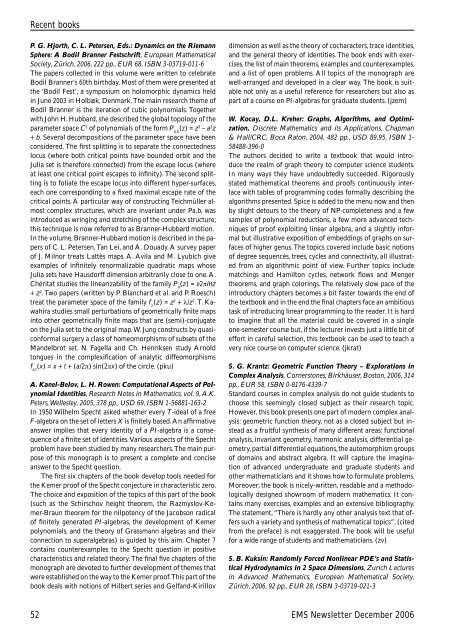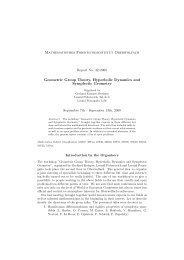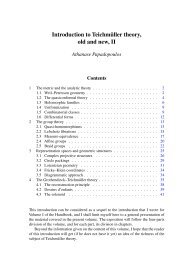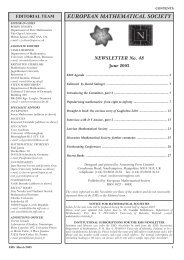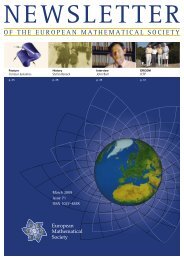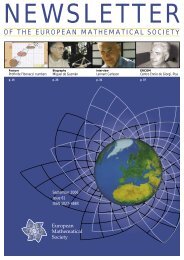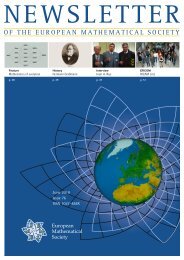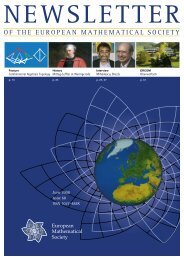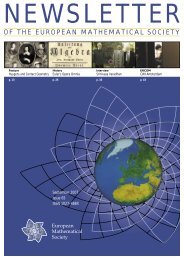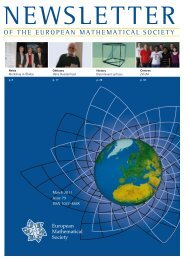Proceedings of the Royal Society of Edinburgh - European ...
Proceedings of the Royal Society of Edinburgh - European ...
Proceedings of the Royal Society of Edinburgh - European ...
Create successful ePaper yourself
Turn your PDF publications into a flip-book with our unique Google optimized e-Paper software.
Recent books<br />
P. G. Hjorth, C. L. Petersen, Eds.: Dynamics on <strong>the</strong> Riemann<br />
Sphere: A Bodil Branner Festschrift, <strong>European</strong> Ma<strong>the</strong>matical<br />
<strong>Society</strong>, Zürich, 2006, 222 pp., EUR 68, ISBN 3-03719-011-6<br />
The papers collected in this volume were written to celebrate<br />
Bodil Branner’s 60th birthday. Most <strong>of</strong> <strong>the</strong>m were presented at<br />
<strong>the</strong> ‘Bodil Fest’, a symposium on holomorphic dynamics held<br />
in June 2003 in Holbæk, Denmark. The main research <strong>the</strong>me <strong>of</strong><br />
Bodil Branner is <strong>the</strong> iteration <strong>of</strong> cubic polynomials. Toge<strong>the</strong>r<br />
with John H. Hubbard, she described <strong>the</strong> global topology <strong>of</strong> <strong>the</strong><br />
parameter space C 2 <strong>of</strong> polynomials <strong>of</strong> <strong>the</strong> form P a,b (z) = z 3 – a 2 z<br />
+ b. Several decompositions <strong>of</strong> <strong>the</strong> parameter space have been<br />
considered. The fi rst splitting is to separate <strong>the</strong> connectedness<br />
locus (where both critical points have bounded orbit and <strong>the</strong><br />
Julia set is <strong>the</strong>refore connected) from <strong>the</strong> escape locus (where<br />
at least one critical point escapes to infi nity). The second splitting<br />
is to foliate <strong>the</strong> escape locus into different hyper-surfaces,<br />
each one corresponding to a fi xed maximal escape rate <strong>of</strong> <strong>the</strong><br />
critical points. A particular way <strong>of</strong> constructing Teichmüller almost<br />
complex structures, which are invariant under Pa,b, was<br />
introduced as wringing and stretching <strong>of</strong> <strong>the</strong> complex structure;<br />
this technique is now referred to as Branner-Hubbard motion.<br />
In <strong>the</strong> volume, Branner-Hubbard motion is described in <strong>the</strong> papers<br />
<strong>of</strong> C. L. Petersen, Tan Lei, and A. Douady. A survey paper<br />
<strong>of</strong> J. Milnor treats Lattès maps. A. Avila and M. Lyubich give<br />
examples <strong>of</strong> infi nitely renormalizable quadratic maps whose<br />
Julia sets have Hausdorff dimension arbitrarily close to one. A.<br />
Chéritat studies <strong>the</strong> linearizability <strong>of</strong> <strong>the</strong> family P θ (z) = e2πiθz<br />
+ z 2 . Two papers (written by P. Blanchard et al. and P. Roesch)<br />
treat <strong>the</strong> parameter space <strong>of</strong> <strong>the</strong> family f λ (z) = z 2 + λ/z 2 . T. Kawahira<br />
studies small perturbations <strong>of</strong> geometrically fi nite maps<br />
into o<strong>the</strong>r geometrically fi nite maps that are (semi)-conjugate<br />
on <strong>the</strong> Julia set to <strong>the</strong> original map. W. Jung constructs by quasiconformal<br />
surgery a class <strong>of</strong> homeomorphisms <strong>of</strong> subsets <strong>of</strong> <strong>the</strong><br />
Mandelbrot set. N. Fagella and Ch. Henriksen study Arnold<br />
tongues in <strong>the</strong> complexifi cation <strong>of</strong> analytic diffeomorphisms<br />
f a,t (x) = x + t + (a/2π) sin(2πx) <strong>of</strong> <strong>the</strong> circle. (pku)<br />
A. Kanel-Belov, L. H. Rowen: Computational Aspects <strong>of</strong> Polynomial<br />
Identities, Research Notes in Ma<strong>the</strong>matics, vol. 9, A.K.<br />
Peters, Wellesley, 2005, 378 pp., USD 69, ISBN 1-56881-163-2<br />
In 1950 Wilhelm Specht asked whe<strong>the</strong>r every T-ideal <strong>of</strong> a free<br />
F-algebra on <strong>the</strong> set <strong>of</strong> letters X is fi nitely based. An affi rmative<br />
answer implies that every identity <strong>of</strong> a PI-algebra is a consequence<br />
<strong>of</strong> a fi nite set <strong>of</strong> identities. Various aspects <strong>of</strong> <strong>the</strong> Specht<br />
problem have been studied by many researchers. The main purpose<br />
<strong>of</strong> this monograph is to present a complete and concise<br />
answer to <strong>the</strong> Specht question.<br />
The fi rst six chapters <strong>of</strong> <strong>the</strong> book develop tools needed for<br />
<strong>the</strong> Kemer pro<strong>of</strong> <strong>of</strong> <strong>the</strong> Specht conjecture in characteristic zero.<br />
The choice and exposition <strong>of</strong> <strong>the</strong> topics <strong>of</strong> this part <strong>of</strong> <strong>the</strong> book<br />
(such as <strong>the</strong> Schirschov height <strong>the</strong>orem, <strong>the</strong> Razmyslov-Kemer-Braun<br />
<strong>the</strong>orem for <strong>the</strong> nilpotency <strong>of</strong> <strong>the</strong> Jacobson radical<br />
<strong>of</strong> fi nitely generated PI-algebras, <strong>the</strong> development <strong>of</strong> Kemer<br />
polynomials, and <strong>the</strong> <strong>the</strong>ory <strong>of</strong> Grassmann algebras and <strong>the</strong>ir<br />
connection to superalgebras) is guided by this aim. Chapter 7<br />
contains counterexamples to <strong>the</strong> Specht question in positive<br />
characteristics and related <strong>the</strong>ory. The fi nal fi ve chapters <strong>of</strong> <strong>the</strong><br />
monograph are devoted to fur<strong>the</strong>r development <strong>of</strong> <strong>the</strong>mes that<br />
were established on <strong>the</strong> way to <strong>the</strong> Kemer pro<strong>of</strong>. This part <strong>of</strong> <strong>the</strong><br />
book deals with notions <strong>of</strong> Hilbert series and Gelfand-Kirillov<br />
dimension as well as <strong>the</strong> <strong>the</strong>ory <strong>of</strong> cocharacters, trace identities,<br />
and <strong>the</strong> general <strong>the</strong>ory <strong>of</strong> identities. The book ends with exercises,<br />
<strong>the</strong> list <strong>of</strong> main <strong>the</strong>orems, examples and counterexamples,<br />
and a list <strong>of</strong> open problems. All topics <strong>of</strong> <strong>the</strong> monograph are<br />
well-arranged and developed in a clear way. The book is suitable<br />
not only as a useful reference for researchers but also as<br />
part <strong>of</strong> a course on PI-algebras for graduate students. (jzem)<br />
W. Kocay, D.L. Kreher: Graphs, Algorithms, and Optimization,<br />
Discrete Ma<strong>the</strong>matics and its Applications, Chapman<br />
& Hall/CRC, Boca Raton, 2004, 482 pp., USD 89,95, ISBN 1-<br />
58488-396-0<br />
The authors decided to write a textbook that would introduce<br />
<strong>the</strong> realm <strong>of</strong> graph <strong>the</strong>ory to computer science students.<br />
In many ways <strong>the</strong>y have undoubtedly succeeded. Rigorously<br />
stated ma<strong>the</strong>matical <strong>the</strong>orems and pro<strong>of</strong>s continuously interlace<br />
with tables <strong>of</strong> programming codes formally describing <strong>the</strong><br />
algorithms presented. Spice is added to <strong>the</strong> menu now and <strong>the</strong>n<br />
by slight detours to <strong>the</strong> <strong>the</strong>ory <strong>of</strong> NP-completeness and a few<br />
samples <strong>of</strong> polynomial reductions, a few more advanced techniques<br />
<strong>of</strong> pro<strong>of</strong> exploiting linear algebra, and a slightly informal<br />
but illustrative exposition <strong>of</strong> embeddings <strong>of</strong> graphs on surfaces<br />
<strong>of</strong> higher genus. The topics covered include basic notions<br />
<strong>of</strong> degree sequences, trees, cycles and connectivity, all illustrated<br />
from an algorithmic point <strong>of</strong> view. Fur<strong>the</strong>r topics include<br />
matchings and Hamilton cycles, network fl ows and Menger<br />
<strong>the</strong>orems, and graph colorings. The relatively slow pace <strong>of</strong> <strong>the</strong><br />
introductory chapters becomes a bit faster towards <strong>the</strong> end <strong>of</strong><br />
<strong>the</strong> textbook and in <strong>the</strong> end <strong>the</strong> fi nal chapters face an ambitious<br />
task <strong>of</strong> introducing linear programming to <strong>the</strong> reader. It is hard<br />
to imagine that all <strong>the</strong> material could be covered in a single<br />
one-semester course but, if <strong>the</strong> lecturer invests just a little bit <strong>of</strong><br />
effort in careful selection, this textbook can be used to teach a<br />
very nice course on computer science. (jkrat)<br />
S. G. Krantz: Geometric Function Theory – Explorations in<br />
Complex Analysis, Cornerstones, Birkhäuser, Boston, 2006, 314<br />
pp., EUR 58, ISBN 0-8176-4339-7<br />
Standard courses in complex analysis do not guide students to<br />
choose this seemingly closed subject as <strong>the</strong>ir research topic.<br />
However, this book presents one part <strong>of</strong> modern complex analysis:<br />
geometric function <strong>the</strong>ory, not as a closed subject but instead<br />
as a fruitful syn<strong>the</strong>sis <strong>of</strong> many different areas: functional<br />
analysis, invariant geometry, harmonic analysis, differential geometry,<br />
partial differential equations, <strong>the</strong> automorphism groups<br />
<strong>of</strong> domains and abstract algebra. It will capture <strong>the</strong> imagination<br />
<strong>of</strong> advanced undergraduate and graduate students and<br />
o<strong>the</strong>r ma<strong>the</strong>maticians and it shows how to formulate problems.<br />
Moreover, <strong>the</strong> book is nicely-written, readable and a methodologically<br />
designed showroom <strong>of</strong> modern ma<strong>the</strong>matics. It contains<br />
many exercises, examples and an extensive bibliography.<br />
The statement, “There is hardly any o<strong>the</strong>r analysis text that <strong>of</strong>fers<br />
such a variety and syn<strong>the</strong>sis <strong>of</strong> ma<strong>the</strong>matical topics”, (cited<br />
from <strong>the</strong> preface) is not exaggerated. The book will be useful<br />
for a wide range <strong>of</strong> students and ma<strong>the</strong>maticians. (zv)<br />
S. B. Kuksin: Randomly Forced Nonlinear PDE’s and Statistical<br />
Hydrodynamics in 2 Space Dimensions, Zurich Lectures<br />
in Advanced Ma<strong>the</strong>matics, <strong>European</strong> Ma<strong>the</strong>matical <strong>Society</strong>,<br />
Zürich, 2006, 92 pp., EUR 28, ISBN 3-03719-021-3<br />
52 EMS Newsletter December 2006


